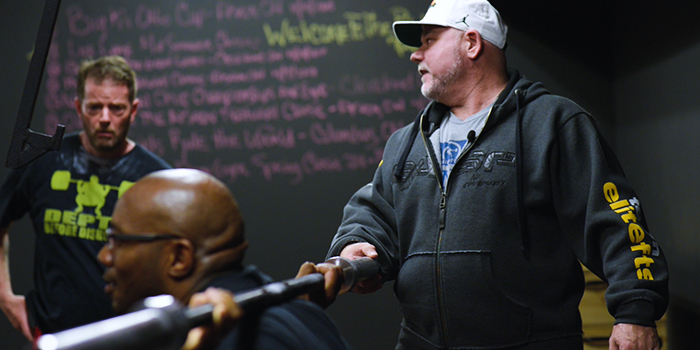
Several weeks ago we shared the story of Welcome to the Pit, Toby and Margo Easterling's training facility in Akron, Ohio. During the visit to set up that gym, Dave spent some time working on squat technique with owners Toby and Margo, and a member from their gym. This video shows the coaching session from the very beginning as each lifter first begins warming up. Starting with a general evaluation to diagnose major issues, Dave points out that Toby lacks the hamstring strength—not the mobility—to reach good depth in a proper squatting position. By adding a little bit more height to their box with a weight plate, they find a comfortable range of motion for Toby to begin working in. He advises Toby to use a box regularly to gauge depth until he can appropriately achieve the full range of motion for a parallel squat.
The second lifter Dave works with has experienced reduced strength in his squat over the course of the last few years, and he's trying to determine if the issue is technical. The first thing Dave sees is that his knees come forward significantly, which he says is somewhat acceptable for lifters in wraps but only to a certain extent. Dave recommends that he change his movement pattern to get his knees closer to mid-foot rather than past his toes forward. To start making this change, Dave has him begin his squat motion by focusing on leading with his hips first before bending at his knees.
Throughout the session, Dave covers the following cues and coaching lessons, among others:
- Even for lifters who aren't going to regularly squat with a box, using the box squat as a teaching tool is a great coaching method. The box enables technical corrections without putting the lifter in an agonizing position in which it's difficult to learn. After learning the technique, it's up to the lifter how long to continue using the box in training.
- To learn to keep your chest up, focus on a direct up-and-down motion of the bar as if it is attached to a Smith machine. The bar should travel in a straight line without any forward lean.
- To stabilize your feet, spread your toes and use them to grab the floor. This is known as rooting. Then as push your hips out while squatting down, you'll "lock in" the muscles that need to be engaged to use a proper movement pattern.
- Think of your midsection as the foundation of your squat. Do you want it to be a marshmallow or a rock? You need to learn to brace, which starts with proper breathing and also includes proper muscular engagement in the midsection. The easiest way to start learning this is by focusing on breathing air into the belly.
- Make sure your feet are even every single time that you set up to squat. If you have to draw marks on the floor to know where to place your feet, do so.
- "Feet, belly, squat" is a good succession of mental cues.










1 Comment